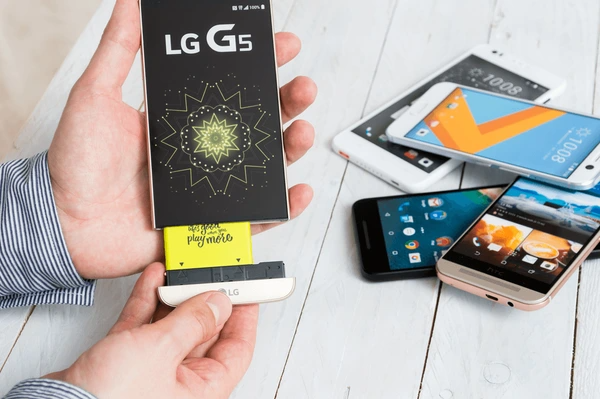
The LG G5, released in 2016, marked a bold step in the smartphone industry with its modular design and advanced features. While it didn’t become a massive commercial success, it introduced innovative concepts that set it apart from other flagship devices of the time. In this article, we’ll dive deep into the LG G5’s design, performance, camera system, modular capabilities, and legacy. This review will provide a professional and data-driven analysis for tech enthusiasts, collectors, and users interested in this once-groundbreaking smartphone.

Key Specifications of the LG G5
The LG G5 offers powerful performance, impressive camera features, and a modular design that sets it apart. If you’re seeking a phone with a stunning display, fast processing, and unique customization, the G5 is worth considering. Below, explore the key specifications to see what makes it a top choice for tech enthusiasts and everyday users.
| Specification | Details |
|---|---|
| Display | 5.3-inch IPS LCD, 1440 x 2560 pixels (554 ppi) |
| Processor | Qualcomm Snapdragon 820, Quad-core 2.15 GHz Kryo |
| RAM | 4 GB RAM |
| Storage | 32 GB internal, expandable via microSD (up to 2TB) |
| Operating System | Android 6.0.1 Marshmallow (upgradable to Android 7.0 Nougat) |
| Battery | 2800 mAh, removable |
| Camera (Rear) | Dual 16 MP (f/1.8) + 8 MP (f/2.4) wide-angle |
| Camera (Front) | 8 MP |
| Build | Aluminum body with removable battery |
| Modular Support | Yes, with LG Friends accessory ecosystem |
| Fingerprint Sensor | Yes |
| Other Features | USB Type-C, Quick Charge 3.0, 4K video recording |
💡 When exploring the key specifications of the LG G5, Eureka Technical Q&A offers expert insights, helping you better understand the device’s features like the camera specs, display resolution, and battery life to ensure you make an informed decision.
Innovative Design and Modular Concept
One of the most talked-about features of the LG G5 was its modular design, aimed at expanding the functionality of the phone. The bottom of the G5 was removable, allowing users to swap out the battery and attach various accessories. These accessories, known as “LG Friends,” included items like the LG Cam Plus for enhanced photography and the Hi-Fi Plus for improved audio quality. While this modular approach didn’t take off as expected, it represented a unique concept in smartphone design.
Key LG Friends Accessories:
- LG Cam Plus: A grip that added a physical shutter button and additional battery for enhanced camera use.
- LG Hi-Fi Plus: An external DAC (digital-to-analog converter) aimed at audiophiles, delivering superior sound quality.
Despite the innovative nature of these accessories, they were ultimately short-lived, and LG shifted away from the modular concept in future models.
Performance and Software Experience
The LG G5 was powered by the Qualcomm Snapdragon 820 processor, paired with 4 GB of RAM. This combo provided solid performance for tasks like gaming, multitasking, and media consumption. However, it couldn’t keep up with newer devices by the time of its release.
Snapdragon 820: As a high-end processor, the Snapdragon 820 delivered strong performance for its era. It handled everyday tasks and demanding apps well but is now considered outdated. Newer models offer faster and more energy-efficient chipsets.
Software and UI: The G5 launched with Android 6.0.1 Marshmallow, later updated to Android 7.0 Nougat. LG’s UX skin offered customization options like home screen adjustments, notification management, and battery life enhancements. However, many criticized the interface as cluttered compared to stock Android.
Display and Media Experience
The LG G5 featured a 5.3-inch Quad HD IPS LCD display, offering vibrant colors and sharp details with a resolution of 1440 x 2560 pixels. While this display was impressive for the time, the lack of OLED technology meant it fell short in terms of deep blacks and contrast compared to contemporaneous devices like the Samsung Galaxy S7.
Display Highlights:
- Color Accuracy: The G5 offered excellent color reproduction, but its brightness levels didn’t reach the peak levels of its competitors.
- Multimedia: Thanks to its Hi-Fi Plus module, users could enjoy superior audio quality, especially when paired with high-quality headphones or external speakers.

Camera Performance: Dual Rear Cameras
The LG G5 was one of the first smartphones to feature a dual-camera setup, consisting of a 16 MP main camera and an 8 MP wide-angle camera. This combination allowed users to capture a variety of scenes, from close-up shots to expansive landscapes, with the wide-angle lens offering a 135-degree field of view.
- Main Camera: The 16 MP sensor produced vibrant and detailed images in well-lit conditions. However, in low light, it was often outperformed by the Galaxy S7 and other contemporaneous flagships.
- Wide-Angle Camera: The 8 MP wide-angle lens allowed users to capture more of the scene, but the quality of wide-angle shots often suffered in terms of sharpness and distortion at the edges.
Camera Features:
- Manual Mode: The G5 offered a robust manual mode, allowing for fine-tuned adjustments to exposure, ISO, and shutter speed.
- Video Recording: The G5 supported 4K video recording, with good stabilization for smooth footage.
While the dual-camera setup was innovative, it didn’t receive the same level of acclaim as later systems, such as those on the iPhone 7 Plus or Huawei P9.
Battery Life and Charging
The LG G5 featured a 2800 mAh removable battery, which was relatively small by modern standards but sufficient for most users. The phone supported Quick Charge 3.0, enabling faster recharges when paired with compatible chargers.
- Battery Life: During typical use, the G5 lasted a full day, though heavy users may have needed to recharge by the evening. The removable battery was a standout feature, allowing users to swap out the battery on the go—something that became rare in subsequent models.
Advantages and Challenges
Advantages:
- Modular Design: A unique feature that allowed users to enhance the phone’s functionality.
- Solid Camera Performance: The dual-camera setup was ahead of its time, particularly with the wide-angle lens.
- Hi-Fi Audio: The addition of LG’s Hi-Fi Plus made it one of the best phones for audiophiles in 2016.
Challenges:
- Modular Ecosystem: The LG Friends accessories didn’t gain traction, and the modular design didn’t catch on in the broader market.
- Battery Life: While it was decent, the 2800 mAh battery was outclassed by other flagship phones of the time.
- Software Issues: The LG UX interface wasn’t as polished as competitors like Samsung’s TouchWiz, making the overall experience feel less fluid.
Conclusion
The LG G5 was a bold experiment in smartphone innovation. It introduced features like a modular design and dual rear cameras, setting it apart from competitors. While the modular concept didn’t catch on as expected, the phone still impressed with solid performance, camera capabilities, and audio enhancements. Though it didn’t achieve commercial success, the G5’s innovations influenced future smartphone designs. If you’re considering the G5 in 2025, it offers unique features for those who appreciate its design. However, it’s important to consider its age and limitations when compared to newer smartphones.
To get detailed scientific explanations of LG G5, try Patsnap Eureka.


